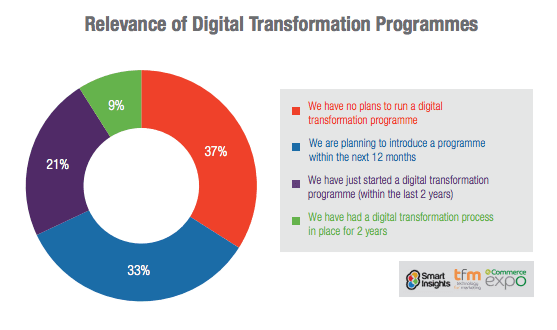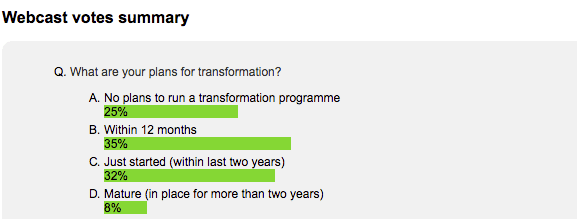Following our Digital Transformation webinar, we look back at some of the questions asked by the audience
It was great to see the interest in our recent digital transformation webinar: Benchmarking your Digital Future (now available on demand).There were so many questions, from strategic to practical, that we couldn’t get to them all on the call, so we promised to share them via our blog.
Before we get into your questions, I want to share a questions I asked attendees, What are your plans for digital transformation? which is a similar to this question in our previous ‘Managing digital marketing research report’.

This is very similar to what we found on the poll in the webinar where around a third of the attendees have plans to start a project within 12 months and a third of attendees have recently launched a programme:

Q. Do you have any recommendations for digital transformation for startups with limited resources and budgets.
Although you don’t have the budgets and resources of a larger organisation, you’re in a strong position since you don’t have legacy processes and martech, so you should be more agile to deploy digital communications.
Regardless of business size, it’s important to get buy-in to the transformation programme early on, so budget holders and team members believe, so it’s important to identify the ‘quick wins’. Although creating a long-term roadmap to deploy new communications techniques and martech should be a deliverable at the outset of the transformation programme, many businesses I speak to ask for ‘quick wins’ to be identified as part of prioritisation of new digital initiatives.
So, in a small business, I recommend reviewing the biggest gap in your communications by reviewing communications across the customer lifecycle. You can use the review in our digital marketing strategy audit to review the gaps and opportunities. Often in small businesses improvements to the website brand messaging or customer journeys or marketing automation will have the biggest, quickest impact since you can take advantage of existing audience interactions, but explain your proposition more effectively, for example on key landing pages, or by improving your welcome email nurture sequence. This should be a relatively low cost solution that doesn’t require a complete re-platforming.
Q. What are some of the most common risks with digital transformation?
It’s great to look at the risks, since I believe risks should be discussed more in marketing planning. We often review change levers and success factors as drivers of projects, but don’t a risk assessment isn’t completed. In the time on the webinar we highlighted two types of risks.
First technology risks of integrating technology, onboarding new systems and populating with data, then configuring them. Since despite what martech vendors may promise, it may take 3 to 6 months for onboarding and using the key operational features of a system. Taking marketing automation as an example, if time isn’t set aside to put in place contact rules for targeting and nurture with welcome emails, you’re not getting the benefits of investing in a new system.
The other main type of risk is the organisational risk. Previously this was lack of buy-in, but it’s not an issue for most members we speak to today. It’s more of an issue for engagement across the business since transformation can impact many parts of the business beyond marketing and IT, for example to Sales, HR and new product development, – so actions need to be taken to mitigate this risk.
Q. How to prepare teams for digital transformation?
With team management it’s a challenge since the digital landscape is changing so fast, so it’s a challenge whether you’re a digital specialist or not. Improving skills amongst brand, product and marketing communications specialist is equally important.
For skills development, start by baseline the skills or competence in your organisation. For our members we have a free personalized learning plan skills assessment for use by individuals or teams.
Then develop a programme of skills development, whether that’s online or face-to-face.
Although skills development is often part of the HR function, in our managing digital teams toolkit we recommend using a digital marketing centre of excellence where one of its key activities is to review performance.
Q. Who owns and drives transformation?
This is a classic question, which is best answered by asking another question, i.e. who owns customer experience since this is a key aspect of transformation which when I ask the question in workshops often suggests a lack of clarity. It’s important to have right type of manager in place to drive change. More business are using a Chief Customer Officer – we looked at the example of the Pru in the talk who using approach, alternatively it could be a VP or Marketing or CMO, but it helps if it’s not a digital specific role with a cross-functional group, for example, it could also be an IT director or CIO who brings together teams from Sales, Marketing, HR and operations.
Q. Should we be developing buyer personas by product category, region, or as more of top level exercise looking at the business as a whole?
As you’ll know from the webinar, we’re huge fans of using personas to develop a shared understanding of audiences in the business and to develop more customer-centric communications.
Setting a scope for personas is challenging in larger, international businesses and particularly in B2B where the buying unit is more complex. Many B2C companies will create 4 to 6 core business personas with a primary persona based on the most important or difficult audience to serve via a website. This can be worthwhile, even in more complex businesses, but if you have markets or products where the product or buying decision factors is quite different such as different vertical industries, it’s worth developing different personas. I see this quite often in B2B since generic personas don’t work for the more detail content mapping needed to get the most from operationalizing personas’.
If you’re interested to learn best practices for creating personas, see the persona examples in our template which include B2B examples.
How tuned do you consider that the Marketing curriculum taught and the research in Digital Marketing at the Higher Education level is at the technological changes? What else do you recommend to be done in this sphere?
I’m not that familiar with the latest HE approaches across many universities, but I do see employer research suggesting that recent graduates are lacking in practical skills that employers are seeking, for example, using channels like search engine, social media or email marketing or in planning and analysing digital marketing activities.
One enlightened university I was speaking at used regular sessions where students were planning and creating content marketing led campaigns and then using the channels above to launch them. There are sufficient free or low-licence fee tools to enable universities to give students hands-on experience if modules and programmes are set up to deliver this.
What’s the most yielding market strategy targeting niches, mainly alike communities like gamers.
This isn’t a sector that I’m familiar with, but participation or creation of communities in a niche like this seems the best approach. I’m sure that won’t be news to you, but to learn potential new approaches it’s worth benchmarking the paid, owned, earned media techniques that competitors are using – to see whether they are getting traction with paid media like programmatic display or Google Display Networkm influencer marketing or direct participation.
Hi Dave, does digital marketing also include engagement with employees, and in what ways?
Yes, it definitely should be, that wasn’t one of my 5 pillars for transformation we covered, but if I expanded it to 10 it would be. Digital transformation is like any other large scale change programme in a business and larger than some previous marketing initiatives that have commonly failed, like implementing CRM since they cut across the business.
Certainly change management for digital transformation. We have this Change management for digital transformation resource developed by Mark Chapman who has overseen many transformation projects which considers how to engage employees through a transformation project.
Do you have stats and source for the insight that if you fail to provide a good UX customers will switch to other providers? How do you define good UX
Sorry, not to have to attribute that insight during the talk! Most of this research is around E-commerce site. Google are always pushing this around site speed on smartphones, here are some of their latest benchmarks and a case study here of how ASDA have implemented PWAs and AMPs to boost conversion giving a 31% increase in mobile conversion since upgrading to PWA1.71X faster site speed. So not strictly about UX. Here are some insights on the impact of experience on loyalty by iPerceptions who are a good service for assessing UX quality.
What’s the most important strategy to focus on for a startup? Mainly in the retail market.
Well, there are many type of retail sectors, so it’s difficult to advise. Across sectors, paid search is the biggest driver of new customer sales for retailers and within that Google Shopping ads now account for 60% of Google Ads clicks across sectors. So, clearly it’s important to get your search marketing right. Marketing Automation remains important for existing customers.
I know you are a great Twitter fan, however my healthcare clients do not get any engagement from prospects. Best to abandon? These are small businesses
I’m more of a LinkedIn fan these days, but yes Twitter is a great way for keeping up-to-date and reaching B2B audiences. For B2C Healthcare which I assume you’re talking about, I’m not surprised engagement is low since Twitter is more of service for keeping up-to-date about news, entertainment, sport, and customer service (to generalise). What you’re suggesting is consistent with what I see, so it’s best to focus on other channels for prospects, i.e. Facebook, email and personalized web messaging.